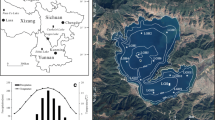Abstract
Heavy metals in urban topsoils have been shown to be very useful tracers of environmental pollution. Thus, their detailed studies are of great importance. Apart from expensive and time-consuming chemical methods, several simple, rapid and cheap proxy methods have been developed recently, one of them being based on rock-magnetic parameters. This examines the use of rock-magnetic methods designed to assess the degree of heavy-metal pollution of urban topsoils from the city of Xuzhou (China). The aim was to identify the magnetic properties and to link the “magnetic pollution” to the concentrations of the heavy metals. Since a strong correlation has been found between saturation isothermal remanent magnetization (SIRM) and the heavy metals, namely, Fe, Se, Ti, Sc, Ba, Bi, Pb, Cu, Zn, Cr and Mo, an anthropogenic contamination origin is thought to be the cause. The present study shows that SIRM is a fast, inexpensive and non-destructive method for the detection and mapping of heavy-metal-contaminated urban topsoils.







Similar content being viewed by others
References
Bacon JR, Berrow ML, Shand CA (1992) Isotopic composition as an indicator of origin of lead accumulations in surface soils. Int J Environ Anal Chem 46:71–76
Banerjee SK (1994) Contribution of fine-particle magnetism to reading the globe paleoclimate record. J Appl Phys 75(10):5925–5930
Bityukova L, Scholger R, Birke M (1999) Magnetic susceptibility as indicator of environmental pollution of soils in Tallin. Phys Chem Earth (A) 24(9):829–835
Chaparro MAE, Gogorza CS, Lavat A, Pazos S, Sinito AM (2002) Preliminary results of magnetic characterization of different soils in Tandil region (Argentina) affected by the pollution of metallurgical factory. Eur J Environ Eng Geophys 7:35–58
Chaparro MAE, Bigegain JC, Sinito AM, Gogorza CS, Jurado S (2003) Preliminary results of magnetic measurements on stream sediments from Buenon Aires Province, Argentina. Stud Geo-Phys Geod 47:53–77
Chaparro MAE, Bigegain JC, Sinito AM (2004) Magnetic studies applied to different environments (soils and stream sediments) from a relatively polluted area in Buenos Aires Province, Argentina. Environ Geol 45:654–664
Dearing JA, Elner JK, Happy-Wood CM (1981) Recent sediment fux and erosional processes in a welsh upland lake-catchment based on magnetic susceptibility measurements. Quatern Res 16:356–372
Desenfant F, Petrovsky E, Rochette P (2004) Magnetic signature of industrial pollution of stream sediments and correlation with heavy metals: case study from South France. Water, Air, Soil Pollut 152:297–312
Durza O (1999) Heavy metals contamination and magnetic susceptibility in soils around metallurgical plant. Phys Chem Earth (A) 24(6):541–543
Flanders P (1994) Collection, measurement, and analysis of airborne magnetic particulates from pollution in the environment. J Appl Phys 75:5931–5936
Hanesch M, Petersen N (1999) Magnetic properties of a recent parabrown-earth from Southern Germany. Earth Planet Sci Lett 169:85–97
Hanesch M, Scholger R (2002) Mapping of heavy metal loadings in soils by means of magnetic susceptibility measurements. Environ Geol 42:857–870
Hanesch M, Scholger R, Rey D (2003) Mapping dust distribution around an industrial site by measuring magnetic parameters of tree leaves. Atmos Environ 37:5125–5133
Hay KL, Dearing JA, Baban SMJ, Loveland P (1997) A preliminary attempt to identify atmospherically-derived pollution particles in English topsoils from magnetic susceptibility measurements. Phys Chem Earth 22(1–2):207–210
Heller F, Strzyszcz Z, Magiera T (1998) Magnetic record of industrial pollution in forest soils of Upper Silesia, Poland. J Geophys Res 103:17767–7774
Hoffmann V, Knab M, Appel E (1999) Magnetic susceptibility mapping of roadside pollution. J Geochem 66 (1–2):313–326
Kapicka A, Petrovsky E, Ustjak S, Machackova K (1999) Proxy mapping of fly-ash pollution of soils around a coal-burning power plant: a case study in Czech Republic. J Geochem Explor 66:291–297
Kapička A, Jordanova N, Petrovsky E, Ustjak (2000) Magnetic stability of power-plant fly ash in different solutions. Phys Chem Earth (A) 25(5):431–436
Kelly J, Thornton I, Simpson PR (1996) Urban geochemistry: a study of the influence of anthropogenic activity on the heavy metal content of soils in traditionally industrial and non-industrial areas of Britain. Appl Geochem 11:363–370
Magiera T, Strzyszcz Z (2000) Ferrimagnetic minerals of anthropogenic origin in soils of some polish national parks. Water, Air, Soil Pollut 124:37–48
Maher BA (1986) Characterisation of soils by mineral magnetic measurements. Phys Earth Planet Interiors 42:76–92
Maher BA, Thompson R, Hounslow MW (1999) Introduction. In: Maher BA, Thompson R (eds) Quaternary climates, environments and magnetism. Cambridge University Press, Cambridge, pp 1–48
Manta DS, Angelone M, Bellanca A, Neri R, Sprovieri M (2002) Heavy metals in urban soils: a case study from the city of Palermo (Sicily), Italy. Sci Total Environ 300:229–243
Peters C, Thompson R (1998) Magnetic identification of selected natural iron oxides and sulphides. J Magn Magn Mater 183:365–374
Petrovsky E, Kapicka A, Zapletal K, Sebestova E, Spanila T, Dekkers MJ (1998) Correlation between magnetic parameters and chemical composition of lake sediments from northern Bohemia—preliminary study. Phys Chem Earth 23(9):1123–1126
Shu J, Dearing JA, More AP, You L, Li C (2000) Magnetic properties of daily sampled total suspended particulates in Shanghai. Environ Sci Technol 34:2392–2400
Thompson R, Oldfield F (1986) Environmental magnetism. Allen & Unwin, London
Vazrrica D, Dongarra G, Sabatina G, Monna F (2003) Inorganic geochemistry of roadway dust from the metropolitan area of Palermo, Italy. Environ Geo 44:222–230
Walling DE, Peart MR, Oldfield F, Thompson R (1979) Suspended sediment sources identified by magnetic measurements. Nature 281:110–113
Author information
Authors and Affiliations
Corresponding author
Rights and permissions
About this article
Cite this article
Wang, XS., Qin, Y. Magnetic properties of urban topsoils and correlation with heavy metals: a case study from the city of Xuzhou, China. Environ Geol 49, 897–904 (2006). https://doi.org/10.1007/s00254-005-0121-0
Received:
Accepted:
Published:
Issue Date:
DOI: https://doi.org/10.1007/s00254-005-0121-0




